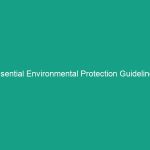Good Morning Team!
Today, we are going to discuss a crucial topic that impacts every one of us in the workplace: Essential Sustainable Procurement Guidelines. Understanding these guidelines is key to avoiding common risks that can affect our health, safety, and Environment (HSE). By the end of this Toolbox Talk, you will have actionable insights to enhance our procurement practices and promote a safer workplace.
Understanding Essential Sustainable Procurement Guidelines
So, what exactly are Essential Sustainable Procurement Guidelines? These guidelines encompass the strategies and practices that organizations implement to ensure that the products and services they procure are environmentally friendly and socially responsible. This is important because sustainable procurement not only minimizes environmental impact but also reduces risks associated with supply chain disruptions, compliance issues, and reputational damage.
Many employees may think that procurement is only about getting the best price. However, it’s vital to understand that sustainable procurement goes beyond cost savings. It involves considering the entire lifecycle of products, from production to disposal, and how these choices impact our health and Safety.
Key Hazards, Risks, and Safety Considerations
When we neglect sustainable procurement practices, several Hazards and risks can arise:
- Environmental Risks: Poorly sourced materials can lead to pollution and environmental degradation. For instance, using materials that are not sustainably sourced can contribute to deforestation and habitat destruction.
- Health Risks: Products that contain harmful chemicals can pose health risks to employees. Understanding the materials used in products helps us avoid exposure to toxic substances.
- Legal and Compliance Risks: Failure to adhere to environmental Regulations can result in hefty fines and legal challenges. Compliance with Standards like ISO 14001 is essential for protecting both the organization and its employees.
- Reputational Risks: Companies that ignore sustainable practices may face backlash from customers and stakeholders, potentially damaging our brand’s reputation.
Ignoring these risks can lead to serious consequences, including workplace accidents, legal penalties, and a damaged reputation. It’s essential to recognize the importance of sustainable procurement in mitigating these hazards and fostering a safer work environment.
Best Practices, Procedures, & Actionable Advice
Now, let’s delve into some Best Practices and Procedures that you can implement to ensure we adhere to sustainable procurement guidelines:
1. Conduct Supplier Assessments
Before engaging with suppliers, conduct thorough assessments to evaluate their Sustainability practices. Ask questions like:
- What certifications do they hold?
- How do they manage waste?
- What measures do they take to reduce their carbon footprint?
By selecting suppliers who prioritize sustainability, we can mitigate risks associated with the procurement process.
2. Implement a Green Procurement Policy
Develop and implement a green procurement policy that outlines your organization’s commitment to sustainability. This policy should include:
- Criteria for selecting sustainable products and services.
- Guidelines for evaluating suppliers based on their environmental impact.
- Strategies for promoting the use of eco-friendly materials.
A clear policy helps everyone in the organization understand the importance of sustainable procurement and encourages compliance.
3. Train Employees on Sustainable Practices
Training is essential for equipping employees with the knowledge and skills needed to implement sustainable procurement practices. Consider the following:
- Organize workshops on sustainable procurement.
- Provide resources on identifying eco-friendly suppliers.
- Encourage discussions about sustainability within teams.
Training fosters a culture of sustainability and empowers employees to make informed decisions.
4. Track and Measure Sustainability Performance
Establish key performance indicators (KPIs) to measure the effectiveness of your sustainable procurement efforts. Regularly review:
- The percentage of eco-friendly products purchased.
- Supplier compliance with sustainability standards.
- Employee engagement in sustainable practices.
Tracking performance helps identify areas for improvement and reinforces our commitment to sustainability.
Regulations, Standards, and Compliance
It’s crucial to be aware of the regulations and standards that govern sustainable procurement. Compliance not only protects our organization but also promotes a safer workplace. Some key regulations to consider include:
- OSHA Standards: Occupational Safety and Health Administration (osha) sets forth safety standards that must be adhered to during procurement processes.
- ISO 14001: This international standard outlines criteria for an effective environmental management system.
- Local Environmental Regulations: Be aware of specific regulations in your region that impact procurement practices.
Understanding and complying with these regulations is essential for minimizing risks and ensuring a safe work environment.
Employee Engagement & Discussion
Now, I want to hear from you! Reflect on the following questions:
- What challenges have you encountered related to sustainable procurement in your work?
- Can you share any examples where sustainable practices have positively impacted your work environment?
- How can we further improve our sustainable procurement practices as a team?
Engaging in discussions about these questions can help us identify areas for improvement and foster a culture of safety and sustainability.
Conclusion & Key Takeaways
In conclusion, adhering to Essential Sustainable Procurement Guidelines is vital for ensuring Workplace Safety and promoting environmental responsibility. Remember the key points we discussed today:
- Understand the risks associated with poor procurement practices.
- Implement Best Practices to promote sustainability.
- Stay informed about relevant regulations and compliance standards.
- Engage in discussions to share experiences and insights.
By prioritizing sustainable procurement, we not only protect ourselves but also contribute to a healthier planet. Thank you all for your attention and commitment to making our workplace safer and more sustainable!


